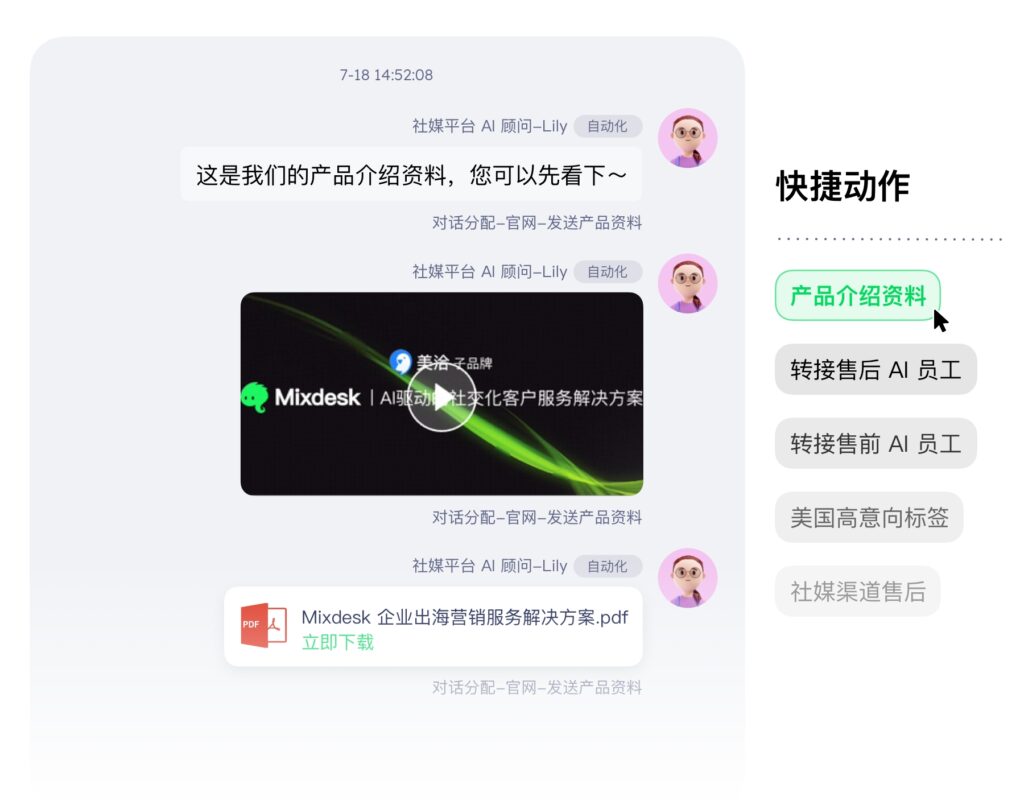Author of this article:Fiona
At a cross-border meeting, Li Xue, the operations manager of Company A, chatted with Deng Ming, the head of social media of Company B. Li Xue sighed: “We now send Facebook messages to hundreds of thousands of potential customers every day, but the effect is bleak. Many people don't reply or click. Before, we blocked several accounts because of mass posting! Deng Ming said with a smile: "We have stepped on the same pit." Later, I used tools to make it safer, not to mention, it can also combine tag grouping, interaction mechanisms, and automatic replies. As a result, the click-through rate increased from 1% to 8%, and the conversion rate tripled. ”
Li Xue was amazed after listening:“It turns out that there are also differences in mass distribution tools, not just ‘can send’ or 'can't send’! ”
With 2.9 billion monthly active users, high-precision crowd targeting,Facebook It has become the core channel for merchants to reach overseas customers. But many businesses have discovered in practice that there is also a way to send mass messages. The use of non-conforming tools or wrong strategies can restrict accounts lightly and titles severely, resulting in customer churn and wasted advertising costs.
This article will start from the pain points and reveal the selection ideas and landing strategies of Facebook mass distribution tools for you, combined with Mixdesk Technical solutions to help you in overseas social mediamarketingStep on the pit less and land quickly.
- First, figure it out first: why do most businesses' Facebook group posts “no effect and no title"?
- 2. Why do you need a dedicated Facebook mass distribution tool?
- 3. 5 key strategies for the selection of Facebook mass distribution tools
- 4. 3 guidelines for avoiding pits: don't make these “mistakes”
- 5. Make Facebook mass distribution a "precise conversion engine”
- FAQ
First, figure it out first: why do most businesses' Facebook group posts “no effect and no title"?
Many businesses feel that "mass posting on Facebook is advertising”, so they can find a free tool to push it in bulk, but they ignore Facebook's strict compliance policies and user experience requirements. These 4 pain points directly lead to operational failure.:
1. Lack of compliance, high risk of account blocking
Facebook has zero tolerance for "spam marketing”. If the tool is not designed for compliance, it can easily trigger risk control: for example, sending too frequently, duplicate content, and not obtaining customer authorization will all be judged as “harassing information”, and the account blocking rate exceeds 85%.
2. Customer layering is vague, and the message is “one size fits all”
Put all customers in one pool and send unified marketing content. New customers feel “unfamiliar with advertising”, and old customers feel “there is no exclusive benefit”, so customers directly ignore it. A cross-border 3C merchant once sent the same “full 200 minus 50” to “new customers who just added friends” and “sleeping customers who haven't interacted for 3 months”. As a result, the conversion rate of new customers was 0.3%, and the opening rate of sleeping customers was only 2%. It was also reported as “spam" by 15% of customers.Message”.
3. Data cannot be tracked, optimize “by feeling”
After mass posting, I only know “how many posts were posted”, but I don't know “how many people opened”, “How many people clicked on the link”, “how many people finally placed the order”, and it is impossible to judge whether the content is valid. It is even more impossible to track the conversion performance of different content.
The result is: the marketing team is busy sending out mass messages every day, but they don't know which messages are working and which are disturbing customers, which not only wastes traffic, but also misses optimization opportunities.
4. Multi-account/multi-channel fragmentation, low management efficiency
Many businesses operate multiple Facebook accounts and also need to synchronize customer data from WhatsApp's private domain, but ordinary tools only support mass distribution of a single account and cannot link data from other channels, resulting in low efficiency and broken customer experience.

2. Why do you need a dedicated Facebook mass distribution tool?
In the absence of special tools, many brands will manually copy and paste mass messages on multiple accounts or pages, which will cause the following problems::
- Extremely low efficiency In the face of tens of thousands of audiences, the cost of copying and sending in batches one by one is extremely high, and manual operations are almost impossible to scale.
- Mass distribution restrictions and title risks Facebook has risk control rules for frequent messaging, duplicate content, and cross-account behavior. If the operation is improper, the account may be restricted from sending messages or blocked.
- Unable to group and label accurately Simple mass distribution lacks pertinence, and the same content is sent to everyone, which can easily lead to low interaction and user unsubscribing.
- Data silos and effects are untraceable After multiple accounts, multiple pages, and multiple messages are sent separately, the open rate, click-through rate, or conversion effect cannot be uniformly counted, making it difficult to resume trading.
- It is difficult to link automation and customer service If the mass distribution tool cannot be connected to CRM and other systems, the message transmission becomes a “one-way output”-no one receives the message after the customer responds, the clue cannot be traced, and the customer service cannot assign it. Ultimately, mass distribution loses its practical significance and becomes an inefficient information bombardment.
Therefore, an ideal Facebook groupTools are not just “able to send", but can support at the same time Efficient, compliant, traceable, linkage of customer management and automation。
3. 5 key strategies for the selection of Facebook mass distribution tools
When choosing a Facebook mass distribution tool, you can judge around the following 5 dimensions:
Strategy 1: Multi-account aggregation and unified management
For cross-border brands, it is often necessary to operate multiple Facebook pages and multiple accounts. The ideal tool should support:
- Multi-accountUnified login and operation
- Mass distribution tasks are executed across accounts
- Display the message logs and reports of multiple accounts in the same interface
Strategy 2: Precise grouping and labeling mechanism
If mass distribution tools only support “one size fits all" messages, then even if they can be sent, it will be difficult to generate conversions. You need tools to have:
- Support “label + group" mechanism
- Can be automatically labeled based on user behavior, attributes, and interaction data
- Support flexible filtering of selected label groups and combined labels when sending in bulk
For example: You can set different tags for “intended users”, “repurchased users”, “Users who browse but have not placed an order”, etc. When sending in bulk, only discounts will be pushed to “intended users”, not everyone.
Mixdesk It can be automatically marked according to user interaction, language, and source channels to help you target mass distribution, increase content hit rates, and reduce harassment.
Strategy 3: Compliance and Risk Control protection
Facebook is very sensitive to the authenticity and user experience of group distribution. Focus on when choosing tools:
- Current limiting control: the tool automatically limits the speed and sends it in batches to avoid short-term and high-density operations.
- IP/login security: there is an anti-title policy
Mixdesk Using top-of-the-line encryption technology,dataStored in Amazon Web Services to ensure data transmission and storage security. At the same time, through the use of independent IP and simulated Web login technology, the title problems caused by inter-account association and frequent switching are avoided, and the account is guaranteed to be safe and stable.
Strategy 4: Linkage between automation and customer service system

If the mass distribution tool is just a "sending tool”, the operating effect is limited. More efficient tools should support:
- Automatic replyRespond with keywords
- The customer service process is triggered after the mass message is clicked (for example, the customer clicks “Learn more” to trigger manual customer service)
- Customer conversion allocation and follow-up management
- Connect with CRM /customer system or customer service platform to achieve message tracking and customer behavior management
Mixdesk As an experienced person in the industrySmart customer serviceThe system has leading intelligent identification and automation linkage capabilities. The system can monitor the customer's click, reply and stay behavior in real time after mass distribution, automatically identify the intent, and trigger the corresponding customer service workflow or label update. Realize the seamless connection between mass distribution and customer service modules, greatly improving response speed and operational efficiency.
4. 3 guidelines for avoiding pits: don't make these “mistakes”
Many businesses choose the right tool, but the effect is poor due to improper operation. These 3 pits must be avoided.:
1. Avoid pit 1: Don't use “free tools” to make large-scale mass distribution
Most of the free tools (such as some browser plug-ins and niche software) are not officially authorized by Facebook, lack compliance design, and will be “pushed in unlimited batches” when sent, which can easily trigger risk control. Li Xue's team was awarded the title because they used the free tool “send 500 posts in 1 hour” and were directly detected by Facebook as abnormal.
suggest: Give priority to tools officially certified by Facebook (such as Mixdesk), Although there is a basic cost, it can avoid the huge loss of account blocking.
2. Avoid pit 2: Don't ignore "content localization”
Sending messages in the same language and the same content to customers in different regions will reduce the willingness to interact: for example, sending English copywriting to Brazilian customers will have a 60% lower open rate than Portuguese.Mixdesk Built-in more than 100 languages, it supports enterprises to connect their own cultural knowledge base to the system for training AI. Let intelligent customer service automatically adjust service tactics and strategies to achieve high-quality communication.
3. Avoid pit 3: Don't “just post in bulk and don't do private domain undertakings”
The core purpose of Facebook mass distribution is to “guide customers into private domains (such as WhatsApp)”. If you only post advertisements and do not undertake them, customers will have no way to consult after clicking on the link, and the conversion will be greatly reduced. A cross-border merchant previously only posted a “new product link” in a mass on Facebook. After the customer clicked, he wanted to consult the size but couldn't find the entrance, and the conversion rate was only 1.2%; Later, he used it to consult the size but couldn't find the entrance. Mixdesk Add a “WhatsApp consultation button” to the mass link, customers can click to jump directly to the chat, and the conversion rate has increased to 8.5%.
5. Make Facebook mass distribution a "precise conversion engine”
In the era of going to sea, brands are increasingly relying on social media to reach customers. Facing the huge traffic pool of Facebook, only by using the right method can “traffic” be turned into “orders”. Facebook's compliance policy will only be stricter. By using compliance and accurate mass distribution tools one step earlier, it can seize the minds of customers one step earlier and lead its peers in overseas private domain competition.
Mixdesk As an omni-channel intelligent customer service platform, it has natural advantages in mass distribution, message aggregation, customer service linkage, automation and data analysis. With it, you can consume less operation and maintenance costs, step on less risk-control minefields, and capture customer insights faster, so that your brand can win in overseas markets.

Mixdesk is an overseas multi-channel intelligent customer communication platform that can unify multiple channels such as Facebook, Instagram, WhatsApp, Line, Telegram, and Email to help companies communicate and serve customers. Mixdesk also supports AI employee functions, allowing enterprises to achieve more efficient automated customer service.
FAQ
Q1: Is there a risk of title in mass posting on Facebook?
A: There are risks. Frequent push, duplicate content, high complaint rate, and frequent cross-account operations will all trigger platform risk control. It is very important to choose tools with speed limit control, content detection, and IP anti-blocking mechanisms.
Q2: Can mass distribution tools support cross-national languages?
A: Yes. Excellent tools should support multi-language text templates, automatically recognize user languages, and send corresponding language messages in groups.
Q3: I already have a customer service system, do I still need to use the mass distribution tool?
A: It can be integrated. The ideal approach is to connect the mass distribution tool with the customer service system, and the mass distribution of messages triggers the customer service process, label updates, and synchronization of customer portraits. Mixdesk is a system that can undertake mass distribution and customer service functions at the same time.
Q4: How to evaluate a mass distribution tool, okay?
A: Focus on the following indicators: delivery stability, open/click/conversion rate, risk control mechanism, labeling ability, data reporting and export ability, and customer service system connectivity.
